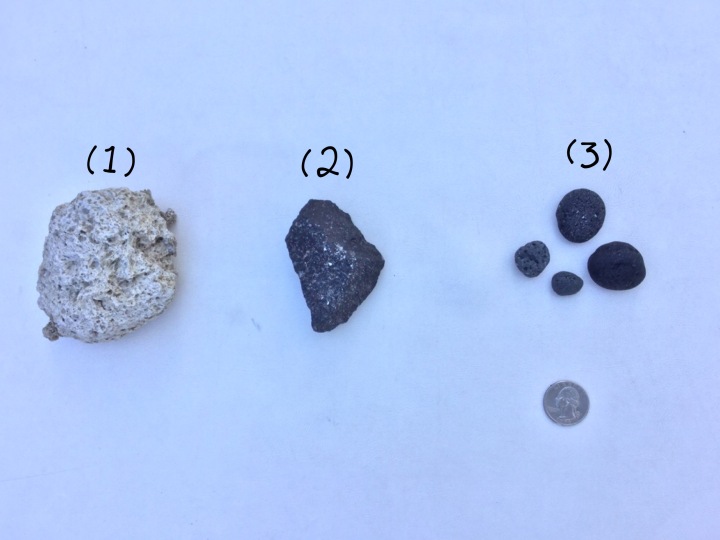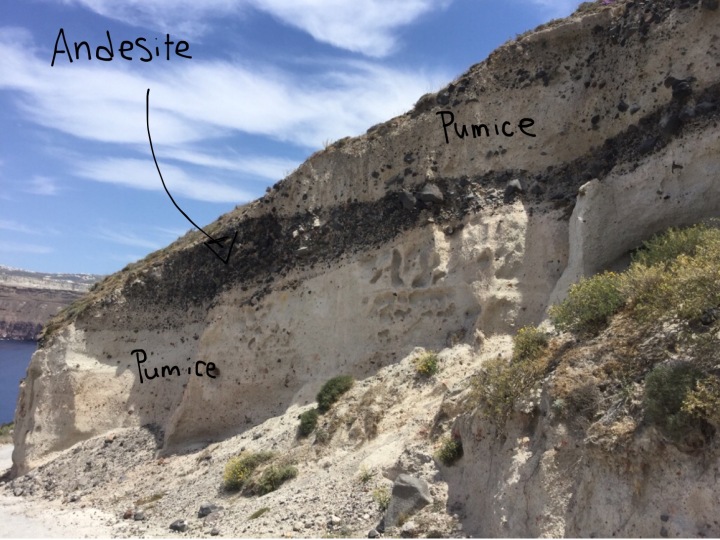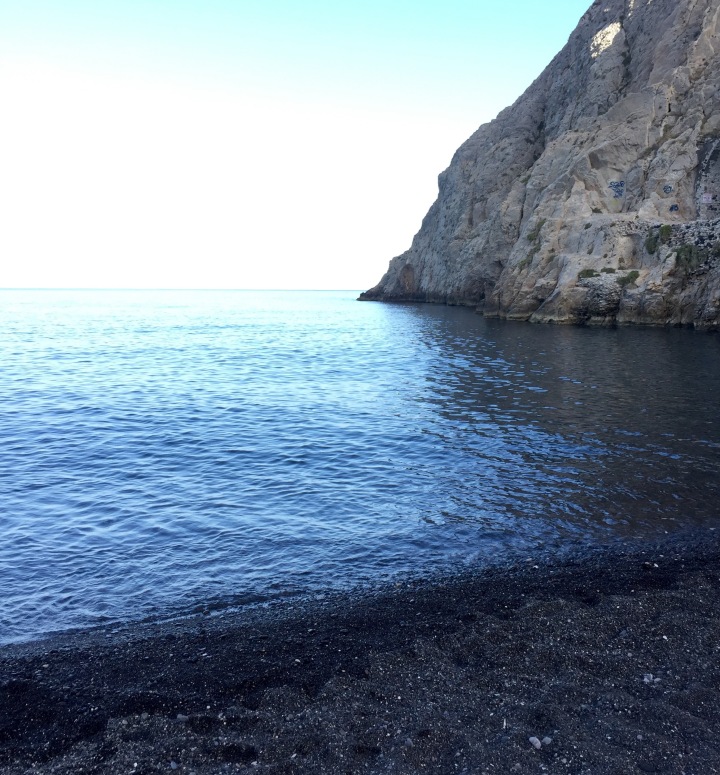At first glance, Santorini is a picturesque pastel paradise. White Cycladic buildings, churches with domes as brilliantly blue as the sea they overlook, even the thick pumice cliffs give the island its blissful ambiance. It has been a week since arriving on this angelic island, and we have swam in the ocean almost every day. This, being from Arizona, has been a much needed godsend, but the view was not at all what I was expecting. Unlike the pearly cities, the beaches we have visited are bejeweled with black porous pebbles.In our geology class, we have learned that the entire island was molded by multiple volcanic eruptions. The most recent Minoan eruption of around 1613 BC [1] blanketed the entire archipelago with white pumice stones (rock #1). So, why were these beaches the exact opposite of the surrounding environment? With a little guidance from our fabulous professor, I came to the embarrassingly simple conclusion. Density!

To the untrained eye, like my own, the 20 meter thick layer of Minoan ash and pumice is a spectacular white barricade. Take a closer look to the figure below, and you will see a clear band of large dark rocks sandwiched between the pumice (rock #2). This was caused by different stages of the historic eruption, and is a much heavier, denser rock type. These are andesite, a mafic to intermediate rock, meaning it was formed during the early stages of lava and have a lower silica content than pumice [2].

Before a large eruption occurs, a rigid dome forms above the volcanic vent. This essentially puts a cap on the volcano and traps magma in until the pressure builds enough to blow it off. These black rocks are fragments of the dome that were ejected during the eruption and thrown several kilometers away.
Aside from being great at rubbing calluses off of your feet, pumice is a light, vesicular volcanic rock that floats in water. This light material, along with ash, eventually washed away, leaving the dense andesite behind. Notice how the cliff on this beach below does not contain either pumice or andesite. This limestone was here long before the Minoan eruption and has watched the pumice come and go to form the beach.

The longer a rock is exposed at the surface of the earth, the rounder and smoother it becomes due to weathering. These rocks, over the course of centuries, have been rubbing, crashing, fracturing against each other to create beautifully smooth pebbles which line the captivating shores (rock #3).
Volcanic deposits, stratigraphy, and the life cycle of rocks may not at first seem alluring to those who are not geologists. I for one, as a civil engineer, never expected to travel across the planet to ponder how pebbles formed and how they got there. But as I sit on Kamari Beach “researching” this topic while sunbathing, I can’t help but to forebode over the idea of leaving this geologic paradise.
References
[1] Friedrich, W, 2009, Santorini: Aarhus, Denmark, Aarhus University Press, 312.
[2] Strickler, M, 1997, Mafic vs Felsic, University of Oregon, http://www.jersey.uoregon.edu

Hanako – good job on integrating the comments that I made on the draft. On figure 1 andesite is spelled wrong and I would also mention in the caption that the rounded pebbles are the same rock type. On figure two I would change caption to be more specific. You know more about that deposit other than that it is volcanic material! I’m looking forward to what you are going to come up with next. This post subject was decidedly simple, yet very informative for those out there that never think about WHY the rocks are there.
Hi Hanako!
I agree with Dr. Skinner that this post is simple, and that it is perfect for someone like me who does not usually wonder about how rocks are formed! Based on your writing style for this post, I can tell that you took into consideration an audience that is unfamiliar with complex geological concepts (this may be because of your own background outside of geology). This is excellent. Even when you use scientific jargon, you follow up with a quick and simple definition. This is a great way to create a balance between using the terminology to show your expertise without alienating your audience.
Your personal narrative throughout is also very engaging. I appreciate your light tone and personal interjections (I definitely chuckled at “Aside from being great at rubbing calluses off of your feet…”). This is perfect for blog writing because it can be a bit more informal and fun, while still demonstrating your credibility about this topic.
The use of images in your post is also appropriate for blog writing because they directly relate to your ideas, and visually they help break up the text which helps readers not get too overwhelmed. You did a great job at directly tying your images into your ideas because you also referenced them directly (such as encouraging the reader to look at the image below and pointing out a certain component of the image for the reader to focus on). Do just make sure that this information is correct and that the captions help readers quickly understand the content of the image. Just like with using sources, having reputable images also increases your credibility as an authority on this topic.
For such a focused topic, you did a great job at bringing the reader along with you on your journey of asking a specific research question, and then doing the research to answer that question. Your conclusions are easy for me to understand as an outside reader. Based on your post, I am interested in knowing if there are larger implications to this geological process and discrepancy you saw between such close areas. I’m not even sure if this can be related to a bigger topic or idea, but by addressing how your research fits into a broader idea gives readers an understanding of the relevancy of your topic and can prompt future research.
Overall, you did a great job at addressing an outside audience and sharing your research in a way that is easily understood. You also show an understanding of blog writing by your use of simple language and several images. For future posts, try bringing in some “big picture” information to compliment your specific research. It will definitely be interesting to see how what you are currently learning contributes to global ideas. Great job!
Marisa
Thanks, Marisa, for taking the time to read my post. Your comment was very helpful, and I hope I’ve made the appropriate corrections. I’ll try to relate my next blog to a bigger picture!
Hey Hanako,
It’s topics like this one that make me love being a geologist. Something as simple as sitting on a beach and looking at rocks can make you think and learn about such large processes like volcanic eruptions. Every rock tells a story and you perfectly captured the little black pebble’s story on Kamari Beach.
When referencing your rocks, it would be easier to reference just the figure so that your reader knows to look at that rock in Figure 1.
In addition to black beaches, there are also red and white beaches on Santorini. As you continue to explore Santorini it would be cool to see updates on this post with short blurbs on where and why these beaches are different colors? What, geologically, is causing the different colors?
Alex